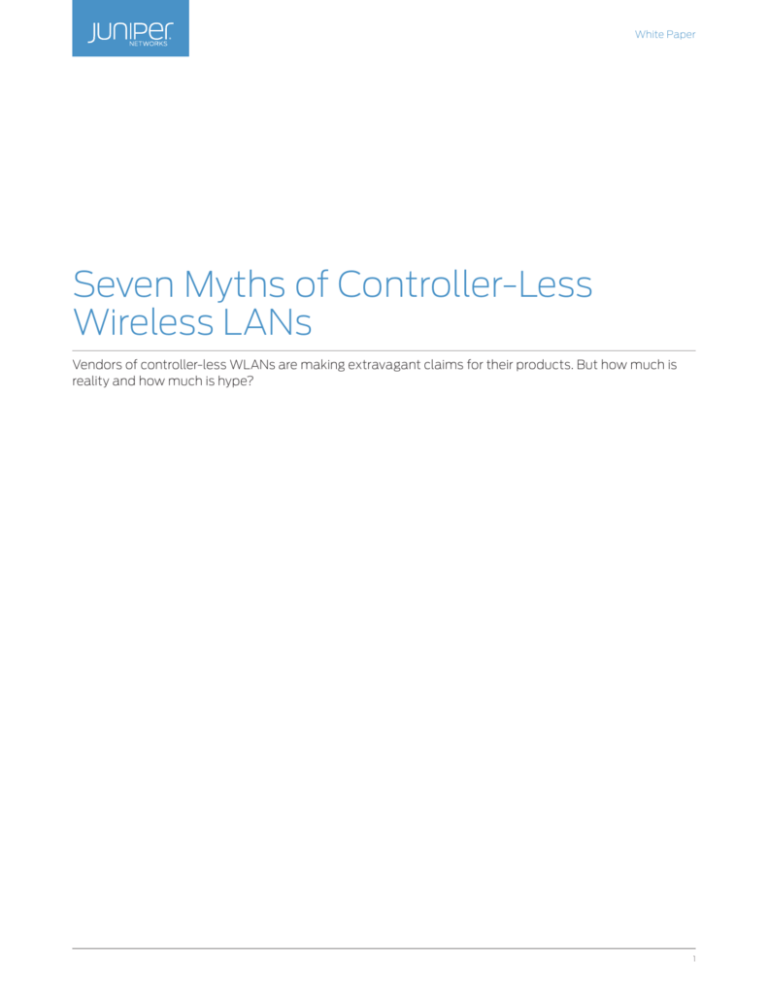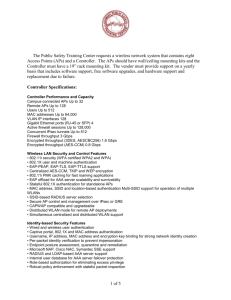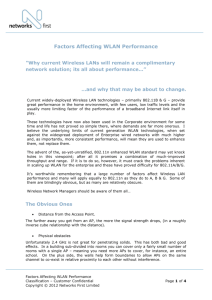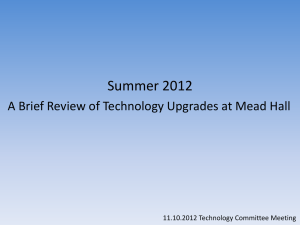
White Paper
Seven Myths of Controller-Less
Wireless LANs
Vendors of controller-less WLANs are making extravagant claims for their products. But how much is
reality and how much is hype?
1
Seven Myths of Controller-Less Wireless LANs
White Paper
Table of Contents
Executive Summary......................................................................................................................................................................................................... 3
Introduction—Controller-Less WLANs: An Interesting but Ultimately Limited Architecture.............................................................. 3
Myth No. 1: Controller-less WLANs are controller-less...................................................................................................................................... 3
Myth No. 2: Controller-less WLANs are easier to deploy ................................................................................................................................. 4
Myth No. 3: Controller-less WLANs are as secure as controller-based WLANs...................................................................................... 4
Myth No. 4: Controller-less WLANs are cheaper ................................................................................................................................................. 5
Myth No. 5: Controller-less WLANs are as reliable as controller-based WLANs.................................................................................... 5
Myth No. 6: Controller-less and controller-based WLANs offer equivalent performance.................................................................. 6
Myth No. 7: Controller-less WLANs are more flexible......................................................................................................................................... 6
Conclusion—Why Juniper............................................................................................................................................................................................... 6
About Juniper Networks..................................................................................................................................................................................................7
©2015, Juniper Networks, Inc.
2
Seven Myths of Controller-Less Wireless LANs
White Paper
Executive Summary
Wi-Fi access isn’t just an afterthought for businesses today. It is an imperative that keeps employees, customers, and
partners productive. With organizations instituting liberal bring-your-own-device (BYOD) policies, users need Wi-Fi access
from a broad range of mobile devices. And no matter which device they choose—laptop, smartphone, tablet, or other—they
must securely and reliably access the systems and applications they need for work, research, and communication.
Keeping up with this need for omnipresent, secure, and reliable wireless network access can be challenging, especially
given the number of deployment options available today. In particular, a number of vendors have introduced controllerless wireless local area network (WLAN) solutions that they claim will meet the WLAN requirements of enterprises, large
and small.
This white paper debunks seven myths in the marketplace about these claims, and shows why, for the majority of
organizations, a controller-based WLAN solution is still the optimal one. Specifically, although the controller-less WLAN
architecture eliminates the centralized physical controller, it nevertheless still requires controller functionality. Network
elements that are not designed to be traffic aggregation points—such as access points (APs)—are used to control
network traffic, potentially resulting in suboptimal performance and security lapses.
Introduction—Controller-Less WLANs: An Interesting but Ultimately Limited
Architecture
As the WLAN market has evolved, smaller niche wireless LAN vendors have introduced a number of interesting
ideas that were designed to make WLANs more reliable, secure, and resilient. Although concepts like phased array
antennas, Wi-Fi arrays, and single channel architecture initially seemed compelling, they don’t meet the needs of most
organizations today.
More recently, controller-less WLAN solutions from Aruba and Aerohive have garnered considerable press, but the true
merits and flaws of this architectural approach have been obscured by marketing hype. A completely controller-less
solution may be viable for certain small- and mid-sized business (SMB) customers who expect their deployments
to remain limited and static. However, as wireless networks grow and serve more complex needs, the advantages of
centralized intelligence and single point of management offered by controller-based solutions continue to be essential
to the successful operation of a WLAN network.
In most use cases, organizations should continue to use controller-based WLANs in their enterprise network
architectures to ensure optimal security, ease of management, highest performance, increases in deployment flexibility,
and reasonable cost. When evaluating WLAN architecture for deployment, organizations should be aware of the
following seven myths about controller-less WLAN solutions.
Myth No. 1: Controller-less WLANs are controller-less
As Wi-Fi networks grew in size and complexity, organizations didn’t have the resources to continue configuring access
points (APs) individually. That’s why the introduction of the WLAN controller was welcomed so enthusiastically by the
IT community; controller-based solutions streamlined and reduced the complexity of configuring and managing the
multiple devices that comprise wireless networks.
The enterprise WLAN market is one of the fastest growing segments in the networking world today. According to IDC’s
Worldwide Quarterly Wireless LAN Tracker, the enterprise WLAN market grew 14.8% year over year in the second quarter
of 2013. Currently, almost all wireless networks are managed by controllers. So-called controller-less deployments
have simply moved the controller function from a centralized appliance to other locations. In most cases, they have
incorporated the controller functionality into the APs themselves or moved it to the cloud. For larger wireless networks,
controller-less WLAN vendors offer management applications that essentially perform functions similar to those of a
controller appliance. In essence, there’s a controller even within a controller-less WLAN system—you just don’t have
control of it.
The point is, there is always a controller. It exists, one way or another. The controller just takes on different forms—and
is paid for in different ways. Vendors that embed the controller functionality in the APs have integrated the cost of the
controller into that of the APs and in the service contracts for the APs. Cloud vendors include the controller costs in the
price of the virtual AP subscriptions.
©2015, Juniper Networks, Inc.
3
Seven Myths of Controller-Less Wireless LANs
White Paper
Myth No. 2: Controller-less WLANs are easier to deploy
This is one of the more persistent myths. Although it’s true that initially, controller-less WLANs appear easier to set up
than those with a centralized controller, the situation changes very quickly once you begin to extend your network.
In a controller-less WLAN system, you need to reconfigure your access layer with the addition of each new AP. Since
it is necessary to configure all virtual LANs (VLANs) on the switch port that is needed by each new AP, your network
administrator needs to configure the wiring closet switches that each new AP connects to. For example, you may have
a VLAN for guest access, a VLAN for corporate access, and a VLAN for special access (such as VoIP). All these VLANs
must be configured each time you add a new AP.
With a controller-based WLAN system, it is infinitely easier to add APs. The access layer is configured once at the
handoff to the controller and the system manages the rest. The centralized controller provides rich functionality for
automating deployment complexity, eliminating the need for frequent, error-prone changes to the access layer. You
simply plug in the AP and it automatically self-configures. Expansion of your network couldn’t be simpler.
Myth No. 3: Controller-less WLANs are as secure as controller-based WLANs
Security is a top priority for network administrators. Monitoring and reacting to system-wide security events requires a
holistic view of the network. This is best provided by a controller-based WLAN.
Most organizations have security policies that determine how to treat untrusted wireless traffic. Controller-based
WLANs offer a very clean and elegant solution to comply with security mandates for isolating untrusted wireless traffic
from the network. For instance, the architecture naturally lends itself to having all traffic terminated at the controller and
transporting all guest traffic to a DMZ or firewall.
In contrast, controller-less WLANs have inefficient workarounds, such as forcing an AP to act as the approved handoff
point for untrusted traffic. A controller is purpose-built for such a function. An AP, on the other hand, is specifically
designed to be a single node on the network; it is not designed to function as an aggregation point. Using APs in this
fashion can put an organization at risk and adversely impact performance.
For example, in a typical enterprise wireless network deployment, secure corporate access is provided to employees,
while limited access is granted to guest traffic. Many organizations, for security reasons, do not allow untrusted guest
traffic to interact with their network. Controllers give organizations an easy way to manage network traffic. Untrusted
traffic gets tunneled to the controller and fed out of a separate physical port to the firewall or other security mechanism
for inspection. An AP can then put trusted traffic instantly on the network, preventing any potential bottlenecks.
A controller-less WLAN system, on the other hand, needs to use one of the APs to provide that physical connection
for guest access. Organizations need to create workarounds with the physical network to allow APs to act as tunnel
termination points.
Organizations frequently choose to place greater security restrictions around wireless network segments than on
the wired segments. The controller-based WLAN model gives enterprises the ability to deploy APs in limited-access
network segments. By leveraging AP-to-controller tunneling, organizations can prevent exposure through unprotected
network ports.
There may be regulatory needs to tunnel traffic to a specific place. For example, compliance with the Health Insurance
Portability and Accountability Act (HIPAA) requires that all wireless traffic go through a central point. Organizations may
also want to route traffic through a central location if they want to meter or control the bandwidth, or to shut down or
disable individual APs.
In a controller-less WLAN architecture, the lack of visibility into system-wide security events provided to APs may also
expose this type of system to additional security risks. Similarly, physical compromise of an AP device can risk exposing
sensitive configuration data. Since each device in a controller-less system is responsible for forwarding client traffic, a
stolen AP can expose the network to an attack; for example, an attacker could open a network port and gain access to
the wired network. This problem would be compounded if the controller-less device required a VLAN trunk to provide
access to multiple VLANs.
All of the above speaks to on-premise WLANs. Deployment of cloud-based WLAN solutions often requires significant
changes to perimeter security policies. (For more on this point, see Myth No. 6.) In addition to the security risk associated
with these changes, there is also the inconvenience of having to manage security by exception.
©2015, Juniper Networks, Inc.
4
Seven Myths of Controller-Less Wireless LANs
White Paper
Myth No. 4: Controller-less WLANs are cheaper
At first glance, controller-less WLANs—especially cloud-based ones—appear less costly than controller-based WLANs.
Certainly, the initial price tag indicates that this is the case. But doing a detailed total cost of ownership (TCO) analysis
quickly refutes that claim.
When comparing the Juniper Networks® JunosV Wireless LAN Controller to an equivalent controller-less WLAN cloudbased solution, we arrived at the following numbers:
Other vendor cloud –based
controller-less WLAN
Juniper controllerbased WLAN
Savings by going with a
controller-based solution
Initial investment
$572,000
$588,110
-3%
Third year
$717,000
$618,330
16%
Fifth year
$862,000
$648,550
33%
This comparison is based on a 500 access point deployment using 3x3, 3 spatial stream 802.11n gear. The other vendor’s
controller-less solution includes cloud controller and enterprise support subscriptions. The Juniper controller-based
solution employs a JunosV Wireless LAN Controller subscription, Juniper Networks Junos® Space Network Director for
management, and an enterprise support subscription.
The following comparison is based on an on-premise controller-less WLAN solution from the same other vendor, again
for 500 access points for an 802.11n wireless network:
Initial investment
Other vendor on-premise
controller-less WLAN
Juniper controllerbased WLAN
Savings by going with a
controller-based solution
$600,999
$588,110
2%
This includes licenses for the vendor’s on-premise WLAN manager software and an enterprise support subscription. The
Juniper cost remains the same as the previous configuration.
Controller-less WLAN systems can be more costly for the following reasons:
• T
he cost of the controller functionality is slipped in elsewhere in a controller-less system (in the cost of required
service contracts, for example).
• T
he cloud model, where the management functionality is located in the cloud, requires a subscription that must
be continuously renewed. Over the long haul, this model is much more expensive than simply purchasing a WLAN
controller from the start.
• F
or non-cloud models, purchase and management of the server system for management software adds cost to
the controller-less solution.
Myth No. 5: Controller-less WLANs are as reliable as controller-based WLANs
In mission-critical wireless networks, the ability to coordinate the failover and failback behavior of a complex system is
critical. Ensuring high availability is a top priority of any WLAN deployment, especially on wireless networks that carry
latency-sensitive traffic such as voice data. Organizations need to be confident that if an AP fails, network traffic won’t be
impacted. All this is best achieved by a centrally managed controller with complete visibility into the entire WLAN system.
With a controller-based model, the controller acts as a single point of coordination for all APs. In case of a failure, the
controller can orchestrate in failure mode to minimize latency. Because all session information for all wireless users
is stored in the centralized controller, in the event that an AP fails, users are immediately transferred to a different AP,
which can get all necessary information about those user sessions from the centralized controller.
However, in the controller-less model, the individual APs don’t have a centralized location to get the necessary user
information. In an outage or AP failure in controller-less WLAN systems, cached credentials, identifiers, or client context
information may be lost and would need to be reestablished on a new AP. As a result, latency can increase. Different
vendors have taken different approaches to manage this problem, but no workaround can completely eliminate this
weakness in the controller-less WLAN architecture.
©2015, Juniper Networks, Inc.
5
Seven Myths of Controller-Less Wireless LANs
White Paper
Myth No. 6: Controller-less and controller-based WLANs offer equivalent
performance
Controller-based solutions provide options to distribute data processing to the local APs, while maintaining the benefits
of centralized command and control. By removing the controller from the data path, potential performance bottlenecks
are eliminated.
Although the controller-less architecture provides a similar optimized data-forwarding path, there is a sacrifice in
performance, since all individual APs must also perform controller functions that are typically performed by a centralized
controller.
Additionally, WLANs are heavily dependent on other components in the network: the authentication server to
authenticate users, network switching to give access to VLANs, and other network management elements. Once
the number of APs reaches a certain threshold, the complexity of coordinating all these components can take a
performance toll, even though the user interface may mask the complexity of the tasks. A larger number of APs also
results in a greater possibility of errors and increased complexity for network administrators to manage.
For example, in a controller-less WLAN system, the AP that is used as the proxy authentication server acts as the
aggregation point for client authentication and must interact with every other AP in the system, resulting in less than
optimal performance. Because every AP has a portal page while also negotiating other types of traffic, there is the
possibility of introducing latency into the system. The larger the environment, the greater the complexity—and the
possibility that performance will suffer.
Taking WLANs to the cloud introduces even more complications, as many of the network elements are on-premise. For
example, Active Directory data will most likely to be located in the data center. If the WLAN controller is in the cloud,
how does that controller communicate through the public Internet, firewalls, and security policies so that users can be
authenticated? The way that the control process is implemented can have very real performance implications.
Then there are the performance implications of tunneling traffic to APs, devices that were not purpose-built for moving
data. APs were not designed to support high-scale tunnel traffic. In contrast, centralized controllers have dedicated
hardware that makes them extremely efficient at moving traffic through the network.
Performance can also be impacted when users roam across multiple access points on a campus. In a controller-less
model, APs are grouped into “pods” to streamline roaming. If these pods get too large and unwieldy, organizations will
see performance degradations. Moreover, individual AP pods may be efficient at managing roaming, but when users
cross pod boundaries, additional performance issues arise; the session will not be seamless for the user and their
connection to the WLAN will likely be interrupted. Managing roaming in a controller-less WLAN is simply not as efficient
as in a centralized controller environment where users can be moved transparently, from one AP to another, with no
impact to performance.
Myth No. 7: Controller-less WLANs are more flexible
Finally, one size does not fit all when it comes to WLANs. Choose an architecture that fits your deployment. A controllerbased WLAN solution offers more choices, and thus more flexibility, than a controller-less WLAN model. With a
controller, organizations can choose to forward traffic locally at the APs (similar to the method used in controllerless WLANs), or they can choose to tunnel certain types of traffic back to the controller for security reasons. With
a controller-based WLAN, organizations have the flexibility to mix and match these approaches as appropriate. A
controller-based architecture also gives enterprises the ability to attach tunneling and local switching to user identities
and roles.
With controller-based WLAN solutions, organizations also have the flexibility to adapt to many different network
topologies and network layouts—precisely because the controller, rather than the individual APs, is the central point of
control.
Conclusion—Why Juniper
The Juniper Networks wireless LAN solution has been a leader in controller-based WLAN since the architecture was
introduced in 2002. The product line was first to market with many of the innovations associated with the “thin AP”
architecture. Today, Juniper offers a broad range of WLAN deployment options for enterprises of all sizes (see Figure 1)
giving you the flexibility to tailor wireless LAN service to meet all of your business needs.
©2015, Juniper Networks, Inc.
6
Seven Myths of Controller-Less Wireless LANs
White Paper
Centralized
Remote Office
Private Cloud
Central Control,
Overlay Data Path
Centralized Configuration
Resilient/Controller-less
Centralized Configuration
Distributed Data Plane
Converged*
Converged wired/wireless
WLC
WLC
VPN
VPN
• Typical enterprise, hospital
• Branch office/teleworker
• Remote AP feature set
• Traditional WLC model
• JunosV WLC in cloud
• Mostly N-S traffic
• Centralized control/
distributed forwarding
• Compliance, accounting
• Mostly local traffic
• Some schools, university
Content
• High E-W traffic, chatty
EX9200
• WLAN control Integrated into
core switch
• WLAN data Integrated into
line card
• Converged control and data
Data
*Roadmap
Figure 1: Juniper Networks controller-based WLAN deployment options
Visit www.juniper.net/wireless to learn more about Juniper’s wireless LAN portfolio.
About Juniper Networks
Juniper Networks is in the business of network innovation. From devices to data centers, from consumers to cloud
providers, Juniper Networks delivers the software, silicon and systems that transform the experience and economics
of networking. The company serves customers and partners worldwide. Additional information can be found at
www.juniper.net.
Corporate and Sales Headquarters
APAC and EMEA Headquarters
Juniper Networks, Inc.
Juniper Networks International B.V.
1133 Innovation Way
Boeing Avenue 240
Sunnyvale, CA 94089 USA
1119 PZ Schiphol-Rijk
Phone: 888.JUNIPER (888.586.4737)
Amsterdam, The Netherlands
or +1.408.745.2000
Phone: +31.0.207.125.700
Fax: +1.408.745.2100
Fax: +31.0.207.125.701
www.juniper.net
Copyright 2015 Juniper Networks, Inc. All rights reserved. Juniper Networks, the Juniper Networks logo, Junos
and QFabric are registered trademarks of Juniper Networks, Inc. in the United States and other countries.
All other trademarks, service marks, registered marks, or registered service marks are the property of their
respective owners. Juniper Networks assumes no responsibility for any inaccuracies in this document. Juniper
Networks reserves the right to change, modify, transfer, or otherwise revise this publication without notice.
2000551-002-EN Sept 2015









